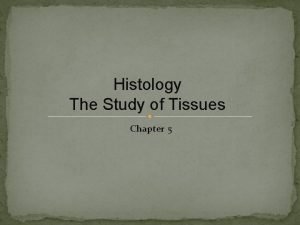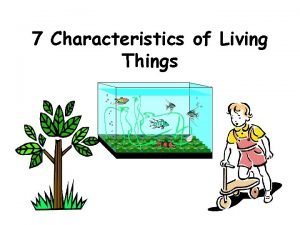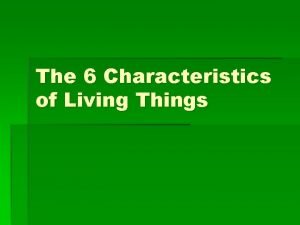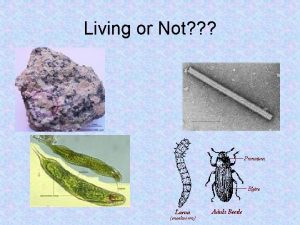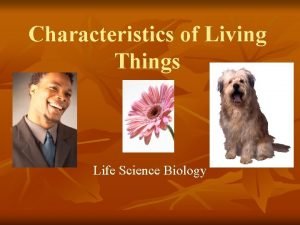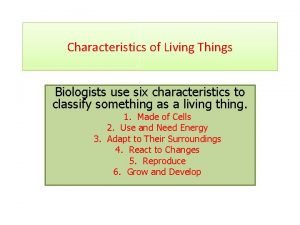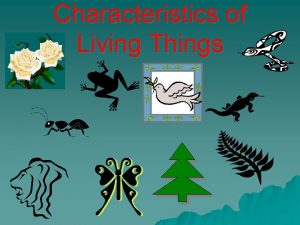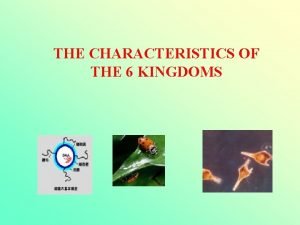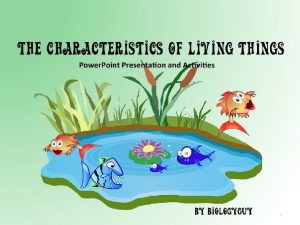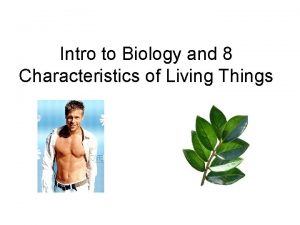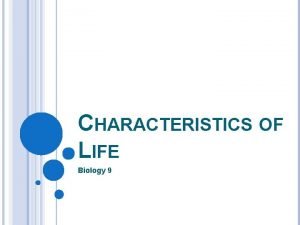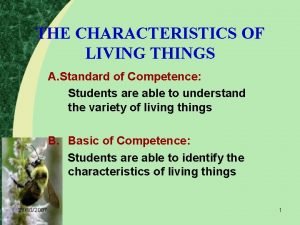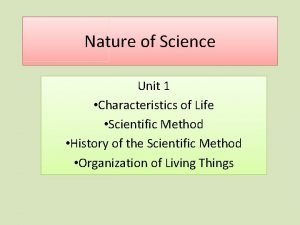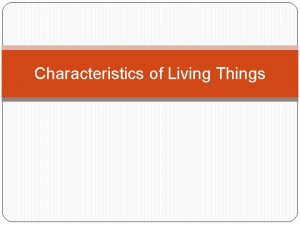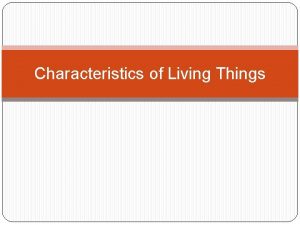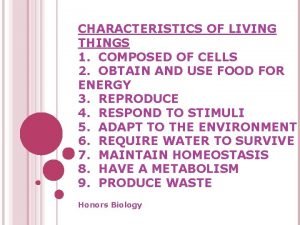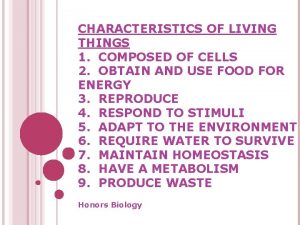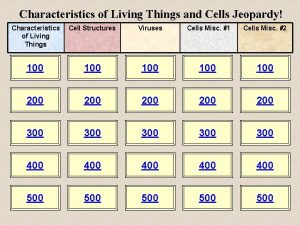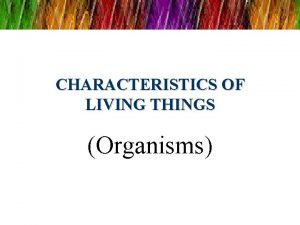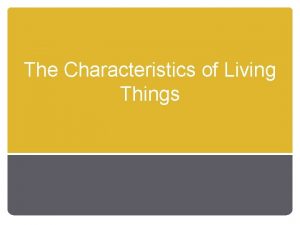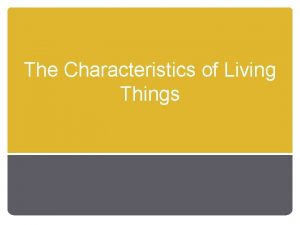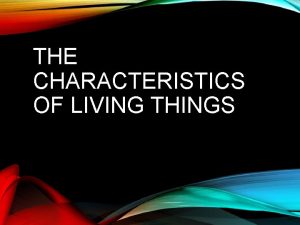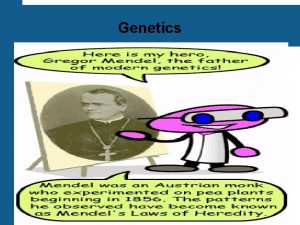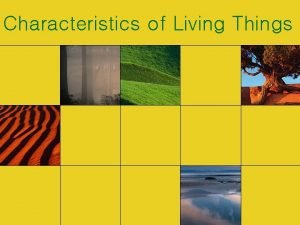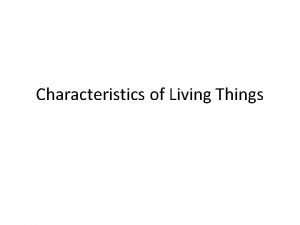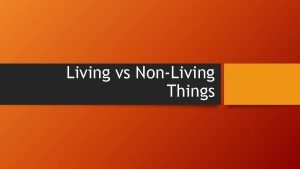7 Characteristics of Living Things COMPOSED OF CELLS






















- Slides: 22

7 Characteristics of Living Things

COMPOSED OF CELLS All living things are made up of at least one cell Cell – • Basic or smallest unit of life § Membrane bound structure in which all life processes are carried out

CELLS All organisms are organized at the cellular level This organization enables organisms to carry out important life processes.

REACT AND RESPOND TO STIMULI • Stimulus – is anything that may cause an organism to react Loud noises, hunger • Response - the reaction to something in the environment Run/cover ears, Eat/hunt for food

Environment – All the surroundings of an organism Homeostasis – maintaining a stable internal environment Adaptation – Change in traits over time that help an organism survive better in an environment; inheritable changes

REPRODUCE · Asexual – single parent produces offspring identical to parent · Sexual – 2 parents produce unique offspring having characteristics or traits of each parent

Contain DNA Deoxyribonucleic Acid Genetic material that contains the “blueprints” for each organism Provides directions for the making of proteins

OBTAIN & USE ENERGY Required to carry out life processesmaking and breaking down food, movement of materials and building of cells Metabolism – the sum of all the chemical processes in an organism

METABOLISM The Sum of All Biochemical Processes 1. Obtain Nutrition Sun is the source of most energy Producers - Make food Consumers - Eat Decomposers – Absorb 2. Digestion – Break down of large food particles into smaller pieces

3. Respiration – Mixing food with oxygen (O 2) to release energy Food + O 2 H 2 O + Waste Energy 4. Synthesis – Process of putting together or building up Making more cells – Growth Repair of Replace old cells 5. Excretion – removal of wastes

GROWTH & DEVELOPMENT • GROWTH – the increase in size of an organism • Surface to volume ratio limits how large a cell can grow

Growth in Single-Celled Organisms In single-celled organisms growth occurs by an increase in cell size Cell can either stay big or divide

Growth in Multi-celled Organisms In multi-celled organisms growth occurs by production of new cells • · Increases the total number of cells in the organism • · Increases total surface to volume ratio

Surface to Volume Surface area Volume O 2 , Food H 2 O Wastes

DEVELOPMENT Development – All the changes an organism undergoes as it grows and matures · Newborn puppies can’t see at birth · Human babies develop the ability to speak and walk

LIFE SPAN All organisms, and individual cells, have a specific life span Includes: Birth Death Stages in Human Life Cycle Birth Infancy Childhood Adolescence Adulthood Advanced Adulthood Death

4 Basic Needs of All Living Things

Food Needed to provide Energy to carry out life processes Ultimate source of energy is the sun Can get food as a producer, consumer or decomposer Provides raw materials for growth and repair

Water Cells contain ~70% water • · Needed to release energy in food and for other biochemical reactions • · Required for transporting materials throughout organism · Helps with dissolving or diluting waste products

Air or Gases · Carbon Dioxide (CO 2) required for photosynthesis - converting of energy from sun into food (glucose) organisms can use · Oxygen (O 2) required for respirationreleasing of energy from food (glucose) into energy organism can use · Other gases are needed in smaller amounts for various life processes; not required by all organisms

Environment Biotic - living parts; Abiotic-non-living parts; physical features other organisms that such as air, water, temperature (climate) Must contain all the needs for that organism to survive meet all 7 characteristics Living things may have to compete for their living space

United Streaming Video
 Cell tissue organ organ system organism
Cell tissue organ organ system organism Difference between living and non living organisms
Difference between living and non living organisms What is the smallest living unit of life
What is the smallest living unit of life Seven life processes grade 4
Seven life processes grade 4 Reticuloendothelial tissue is composed of cells that are
Reticuloendothelial tissue is composed of cells that are 7 characteristics of life
7 characteristics of life Six characteristics of living things
Six characteristics of living things Movement characteristics of living things
Movement characteristics of living things Six characteristics of living things
Six characteristics of living things What are the six characteristics of life
What are the six characteristics of life Two characteristics of living things
Two characteristics of living things What are the 9 characteristics
What are the 9 characteristics Characteristics of animals as living things
Characteristics of animals as living things Mrsgren
Mrsgren Characteristics of animals as living things
Characteristics of animals as living things 8 characteristics of living things
8 characteristics of living things Characteristics of living things ppt
Characteristics of living things ppt 9 characteristics of life
9 characteristics of life 10 characteristics of living things
10 characteristics of living things Characteristics of living things
Characteristics of living things 7 characteristics of living things
7 characteristics of living things Sphenoid paranasal sinus
Sphenoid paranasal sinus Regulation of tubular reabsorption
Regulation of tubular reabsorption




